Q1: Consider the set X = {a, b, c, d, e} under the partial ordering R = {(a, a), (a, b), (a, c), (a, d), (a, e), (b, b), (b, c), (b, e), (c, c), (c, e), (d, d), (d, e), (e, e)}.
The Hasse diagram of the partial order (X, R) is shown below.
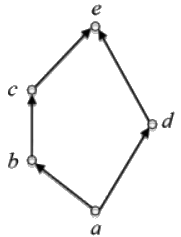 The minimum number of ordered pairs that need to be added to R to make (X, R) a lattice is _____. (2017 SET-2)
The minimum number of ordered pairs that need to be added to R to make (X, R) a lattice is _____. (2017 SET-2)
(a) 0
(b) 1
(c) 2
(d) 3
Ans: (a)
Sol: A Hasse Diagram is called a Lattice if, for every pair of elements, there exists a LUB and GLB.
In the above Hasse Diagram, LUB and GLB exist for every two elements taken from {a, b, c, d, e}. So, it is already a Lattice.
Hence, the Minimum number of ordered pairs that need to be added = 0.
Q2: Suppose L= {p, q, r, s, t} is a lattice represented by the following Hasse diagram:
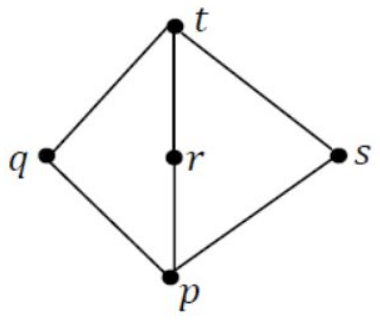 For any x, y ∈ L not necessarily distinct, x ∨ y and x ∧ y are join and meet of x, y respectively. Let L3 = {(x, y, z) : x, y, z ∈ L} be the set of all ordered triplets of the elements of L. Let Pr be the probability that an element (x, y, z) ∈ L3 chosen equiprobably satisfies x ∨ (y ∧ z) = (x ∨ y) ∧ (x ∨ z). Then (2015 SET-1)
For any x, y ∈ L not necessarily distinct, x ∨ y and x ∧ y are join and meet of x, y respectively. Let L3 = {(x, y, z) : x, y, z ∈ L} be the set of all ordered triplets of the elements of L. Let Pr be the probability that an element (x, y, z) ∈ L3 chosen equiprobably satisfies x ∨ (y ∧ z) = (x ∨ y) ∧ (x ∨ z). Then (2015 SET-1)
(a) Pr = 0
(b) Pr = 1
(c) 0 < Pr ≤ 1/5
(d) 1/5 < Pr < 1
Ans: (d)
Sol: Number of elements in L3 = Number of ways in which we can choose 3 elements from 5 with repetition = 5 ∗ 5 ∗ 5 = 125.
Now, when we take x = t, then the given condition for L is satisfied for any y and z. Here, y and z can be taken in 5 ∗ 5 = 25 ways.
Take x = r, y = p, z = p. Here also, the given condition is satisfied.
When x = t, we have 5 ∗ 5 = 25 cases (for any y and z) where the given conditions are satisfied. Now, with x = r, y = p, z = p, we have one more case. So, 26/125 which means strictly greater than 1/5.
So, this makes pr>(25/125) Also,
for x = q, y = r, z = s, the given condition is not satisfied as q ∨ (r ∧ s) = q ∨ p = q, while (q ∨ r) ∧ (q ∨ s) = t ∧ t = t. So, pr ≠ 1.
These findings make option A, B, C as FALSE.
Hence, answer = option D
Q3: Consider the following Hasse diagrams.
(i)  (ii)
(ii) 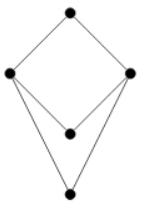 (iii)
(iii) 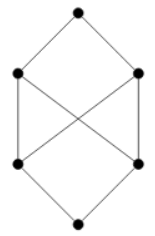 (iv)
(iv) 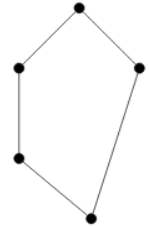 Which all of the above represent a lattice? (2008)
Which all of the above represent a lattice? (2008)
(a) (i) and (iv) only
(b) (ii) and (iii) only
(c) (iii) only
(d) (i), (ii) and (iv) only
Ans: (a)
Sol: Hasse diagram is lattice when every pair of elements have a least upper bound and a greatest lower bound. In figures (ii) and (iii), every element is not having a least upper bound and a greatest lower bound (these if exist will be unique as per their definitions). So, they are not lattices.
Q4: The following is the Hasse diagram of the poset [{a, b, c, d, e}, ≺ ]
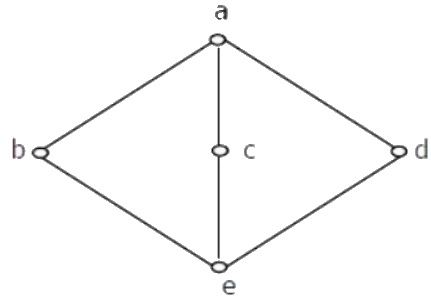 The poset is: (2005)
The poset is: (2005)
(a) not a lattice
(b) a lattice but not a distributive lattice
(c) a distributive lattice but not a Boolean algebra
(d) a Boolean algebra
Ans: (b)
Sol: A lattice has a least upper bound (lub) and a greatest upper bound (glb), but to be distributive every element of the lattice should have at most one complement. Here, elements b, c, d are complements of each other and hence the given lattice is not distributive.
Q5: The inclusion of which of the following sets into
S = {{1, 2}, {1, 2, 3}, {1, 3, 5}, {1, 2, 4}, {1, 2, 3, 4, 5}}
is necessary and sufficient to make S a complete lattice under the partial order defined by set containment? (2004)
(a) {1}
(b) {1}, {2, 3}
(c) {1}, {1, 3}
(d) {1}, {1, 3}, {1, 2, 3, 4}, {1, 2, 3, 5}
Ans: (a)
Sol: A lattice is complete if every subset of partial order set has a supremum and infimum element.
For example, here we are given a partial order set S. Now it will be a complete lattice if whatever be the subset we choose, it has a supremum and infimum element. Here relation given is set containment, so supremum element will be just union of all sets in the subset we choose. Similarly, infimum element will be just intersection of all the sets in the subset we choose.
Now as we can see, S now is not complete lattice, because although it has a supremum for every subset we choose, but some subsets have no infimum. For example: if we take subset {1, 3, 5} and {1, 2, 4} then intersection of sets in this is {1}, which is not present in S. So clearly, if we add set {1} in S, we will solve the problem. So, adding {1} is necessary and sufficient condition for S to be complete lattice. Thus, option (A) is correct.
 The minimum number of ordered pairs that need to be added to R to make (X, R) a lattice is _____. (2017 SET-2)
The minimum number of ordered pairs that need to be added to R to make (X, R) a lattice is _____. (2017 SET-2) For any x, y ∈ L not necessarily distinct, x ∨ y and x ∧ y are join and meet of x, y respectively. Let L3 = {(x, y, z) : x, y, z ∈ L} be the set of all ordered triplets of the elements of L. Let Pr be the probability that an element (x, y, z) ∈ L3 chosen equiprobably satisfies x ∨ (y ∧ z) = (x ∨ y) ∧ (x ∨ z). Then (2015 SET-1)
For any x, y ∈ L not necessarily distinct, x ∨ y and x ∧ y are join and meet of x, y respectively. Let L3 = {(x, y, z) : x, y, z ∈ L} be the set of all ordered triplets of the elements of L. Let Pr be the probability that an element (x, y, z) ∈ L3 chosen equiprobably satisfies x ∨ (y ∧ z) = (x ∨ y) ∧ (x ∨ z). Then (2015 SET-1) (ii)
(ii)  (iii)
(iii)  (iv)
(iv)  Which all of the above represent a lattice? (2008)
Which all of the above represent a lattice? (2008) The poset is: (2005)
The poset is: (2005)




















